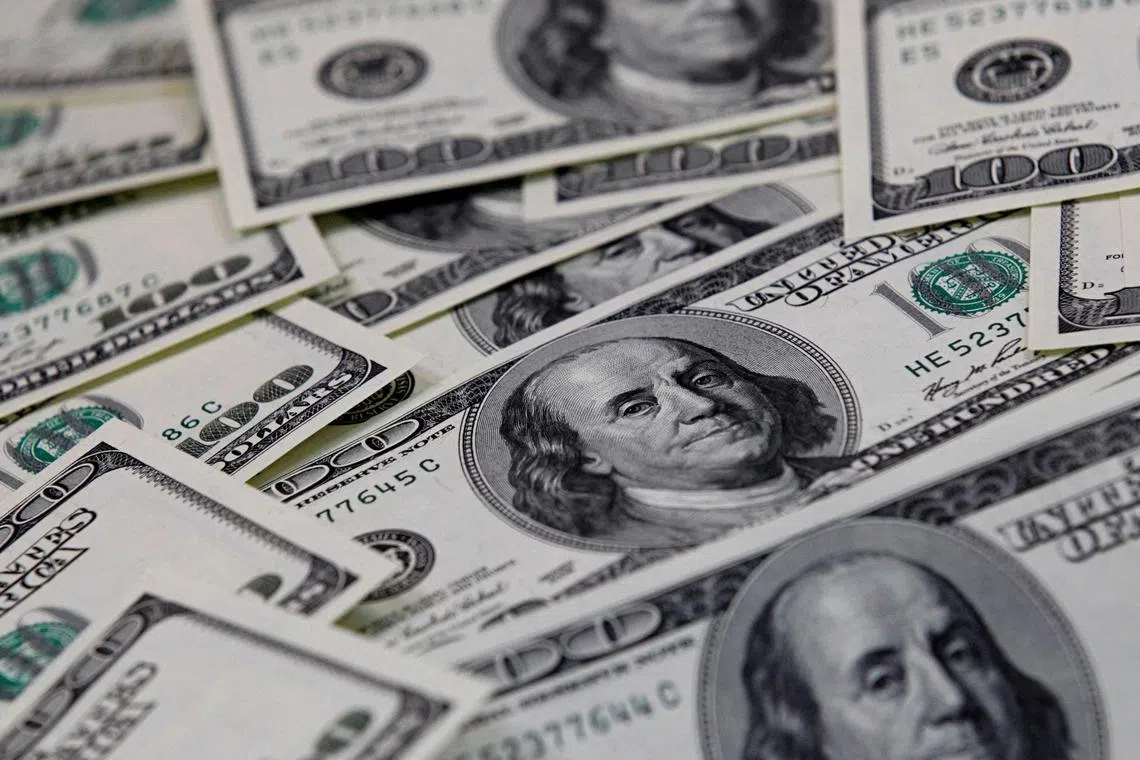Tumbling US dollar a boon to risk assets across the globe
Sign up now: Get ST's newsletters delivered to your inbox

The US dollar is down nearly 13 per cent against a basket of currencies from last year’s two-decade high
PHOTO: REUTERS
Follow topic:
NEW YORK - Cooling US inflation is accelerating a decline in the US dollar, and risk assets around the world stand to benefit.
The dollar is down nearly 13 per cent against a basket of currencies from 2022’s two-decade high
Its decline quickened after the United States reported softer-than-expected inflation data on Wednesday, supporting views that the US Federal Reserve is nearing the end of its interest rate hiking cycle.
Because the dollar is a linchpin of the global financial system, a wide range of assets stands to benefit if it continues falling.
Weakness in the dollar can be a boon to some US companies, as a weaker currency makes exports more competitive abroad and makes it cheaper for multinationals to convert foreign profits back into dollars.
The US technology sector, which includes some of the big growth companies that have led markets higher in 2023, generates just over 50 per cent of its revenues overseas, an analysis of Russell 1000 companies by Bespoke Investment Group showed.
Raw materials, which are priced in dollars, become more affordable to foreign buyers when the dollar declines. The S&P/Goldman Sachs Commodity Index is up 4.6 per cent in July, on pace for its best month since October.
Emerging markets benefit as well, because a falling US currency makes debt denominated in dollars easier to service. The MSCI International Emerging Market Currency Index is up 2.4 per cent in 2023.
“That sound you hear is the breaking of technical levels across the foreign exchange markets,” said Mr Karl Schamotta, chief market strategist at Corpay. “The dollar is plunging towards levels that prevailed before the Fed started hiking, and we’re seeing risk-sensitive currencies melt up on a global basis.”
A continued fall in the dollar could boost profits for foreign exchange strategies such as the dollar-funded carry trade, which involves the sale of dollars to buy a higher-yielding currency, allowing the investor to pocket the difference.
The dollar’s decline has already made the strategy a profitable one in 2023: An investor selling dollars and buying the Colombian peso would have collected 25 per cent year to date, while the Polish zloty has yielded 13 per cent, data from Corpay showed.
In the world of monetary policy, the dollar’s decline may be a relief to some countries, as it removes the urgency for them to support their falling currencies.
Among them is Japan. The greenback has tumbled 3 per cent against the yen this week and is set for its biggest weekly fall against the Japanese currency since January. Yen weakness has been problematic for Japan’s import-reliant economy and raised expectations Japan would again intervene in markets to support its currency after doing so for the first time since 1998 last year.
Continued strength in the yen could see investors unwind the large bearish positions that have built up against the currency in recent months, pushing it higher, said Societe Generale currency strategist Kenneth Broux.
Of course, being bearish on the dollar has its own risks. One is a potential rebound in US inflation, which could stoke bets on more Fed hawkishness and unwind many of the anti-dollar trades that have prospered in 2023.
Though inflation has cooled, the US economy has remained resilient compared with other countries, and few believe the Fed will cut rates any time soon, which could potentially limit the dollar’s near-term downside.
Still, Ms Helen Given, forex trader at Monex USA, believes that the Fed will wrap up its rate-hiking cycle before most other central banks, sapping the dollar’s long-term momentum.
While the dollar may pare some of its recent losses, “looking six months out, it’s likely the dollar will be even weaker than it is today”, she said. BLOOMBERG

